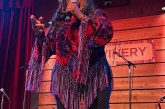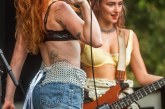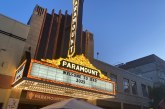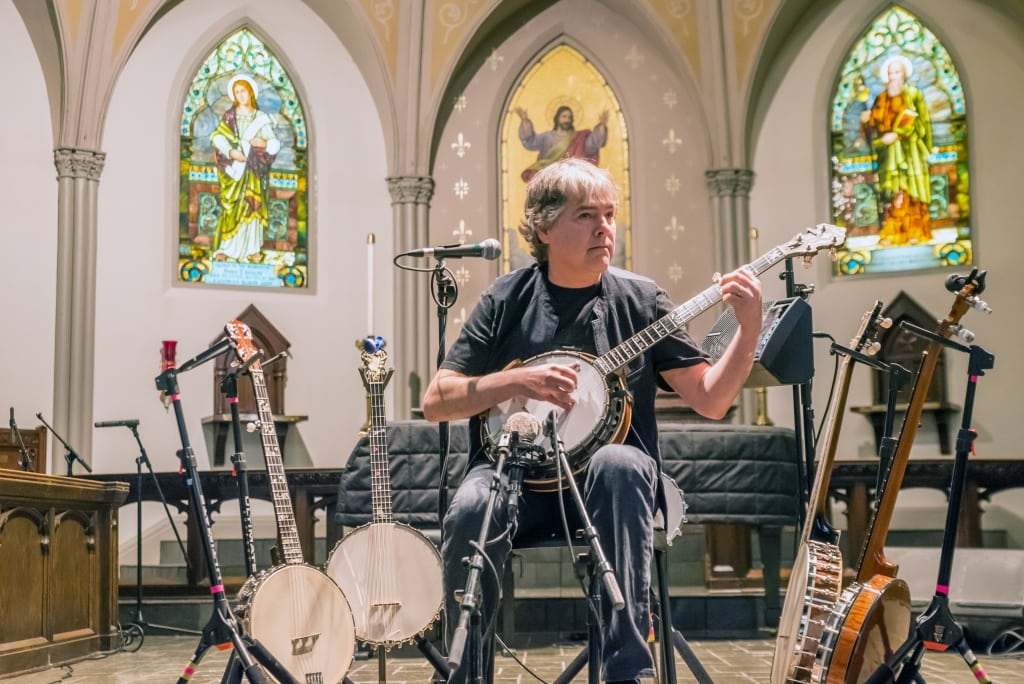
By Wayne Bledsoe, Luke Brogden, Jennifer Duncan-Rankin, Bill Foster, Mickey Ketron, Rusty Odom and Matt Rankin
THURSDAY Recap • Friday Recap • SATURDAY Recap • BIG EARS Guide
Songs of Our Ancestors panel discussion featuring Rhiannon Giddens, Rachel Grimes and Richard Thompson, moderated by Ann Powers from NPR Music
Though I consider myself a music fan, I even more closely connect with the archives, the history and the stories that trace the evolution of both our individual and collective culture. Before I went back to college (for the fourth time), I would spend hours at the library and in the McClung Archives poring over newspapers, microfiche, funeral programs and the ilk, hungry to learn more about where I come from. With that, I could not pass up the opportunity to listen to artists I respect and admire discuss the influence of these personal stories on our music and their importance in not only understanding where we’ve been, but where we are and especially where we’re going.
Each panelist has used archival sources in their music. Richard Thompson will be debuting material created from examining items such as letters, diaries and recruitment material from World War 1 to contrast the advertised glory and honor of war to the reality of horror and our own fragility. Rachel Grimes, best known for her more traditional and primarily instrumental piano work, felt it necessary to write lyrics and poetry to present the stories she found while researching her own family tree. She told the audience about finding a deed for a woman, Susan, and her three children. She expressed hope that Susan was kept with her three children “for some humane reason.” Rhiannon Giddens, the lifelong student who has made study of history such an integral part of her work, pleaded with the audience to examine the lessons of the past. She compared our modern-day problems to those of the 1850s, exclaiming they are why we are who we are today, that we’ve made these mistakes before and to just “stop it.”
The trio examined the so-called “folk revival” and how, though its popularity allows us to reconnect with the lessons of the past, we must be careful to not guard it so closely that we rigidly define what it is. In Giddens’ words, “Tradition should be a guide, not a jailor.” Folk music is cyclical, ever changing and evolving. Thompson was quick to remind the audience of the influence of technology on folkways, while Giddens acknowledged that technology gives us more access to archival material than we could have ever thought possible before.
However, Giddens was quick to caution against insisting on becoming cultural purists who attempt to define what culture must be. We have our internal malarkey gauge and should just leave it at that. All three panelists will be debuting new material over the festival weekend that incorporates archival material. For you local folks, the fifth floor of the East Tennessee History Center is the ideal place to get started exploring the stories of our past. – Jennifer Duncan-Rankin
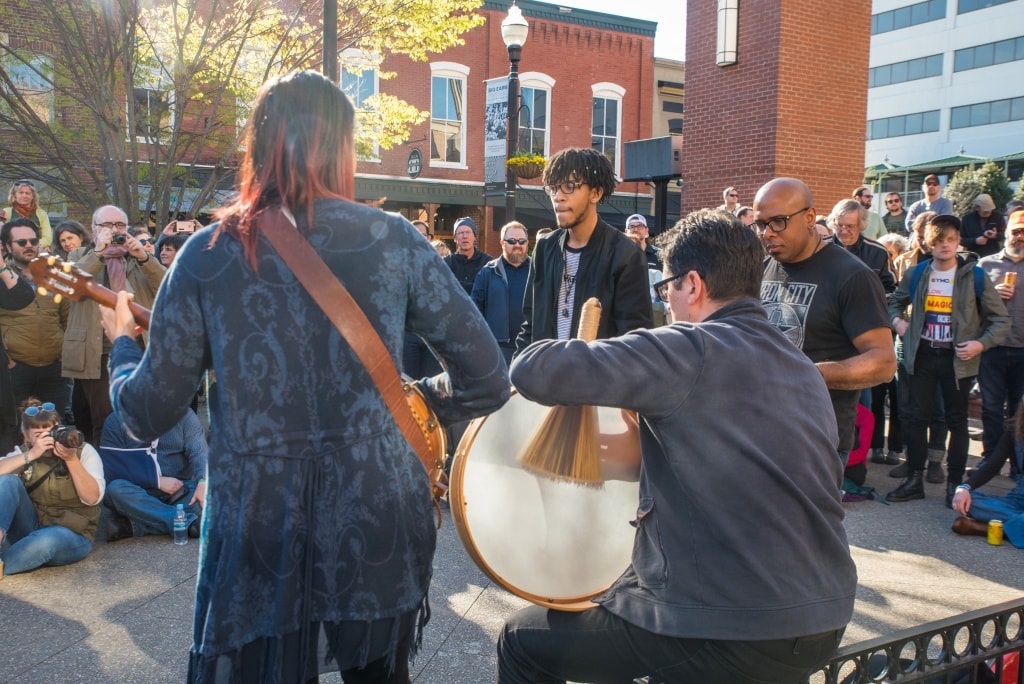
Amirtha Kidambi’s Elder Ones
I wasn’t sure what to expect when I went to the exquisite St. John’s Cathedral to see Amirtha Kidambi’s Elder Ones, but when Kidambi began to play pump organ and said, “This song is called ‘Eat the Rich’ and that is truly how I feel,” I was hooked. Kidambi stated that her intent was to confront the audience, to have them leave feeling energized and a bit angry and she delivered that in spades. Backed by master saxophonist Matt Nelson, whose screaming solos were as dissonant or melodic as required, the sensory drums of Max Jaffe and bassist Nick Dunston, Kidambi’s voice was powerful, engaged and enraged. Like Tanya Tagaq, her impenetrable phrasing and wordless sounds convey more meaning and understanding than actual words ever could, as the Elder Ones delivered the closest thing to jazz-metal the cathedral likely will ever see. – Bill Foster
“Dragnet Girl” live score by Coupler
How many times do you get to see a Japanese silent gangster romance film – if you even knew such a thing existed in the first place? The electronic trio Coupler provided a fine soundtrack to the 1933 noir for a free Big Ears show at the Knoxville Museum of Art. The music was moody, and the film, directed by Yasujiro Ozu, was a surprisingly strong tale with a more meandering storyline than American films at the time. The musicians took the project seriously, and the audience appreciated it. – Wayne Bledsoe
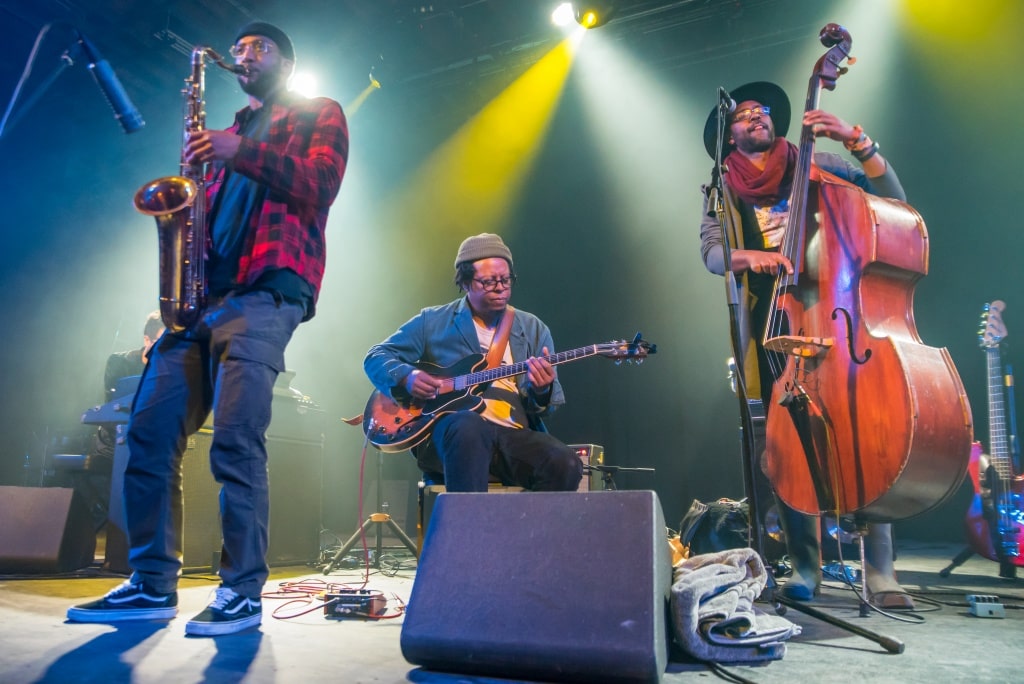
Mosaic: Memories
Part of a three-piece work by an international cast of musicians and filmmakers, the Mosaic project is one of those rare shows that could only appear at a festival such as Big Ears. Presented at the Square Room, the audience was invited to sit on pillows in a roped-off area between two curtain screens and flanked by instrumentalists and vocalists. While one screen concentrated on a film of an Appalachian woman telling memories of her mother and growing up, sometimes with her own singing, the other screen featured scenes of Kurdish women from Turkey and Turkish music. At moments, the assembled musicians would take over the music or augment what was being delivered in the film. Style of fiddle/violin, vocals and percussion were blended and contrasted. It was beautiful. The point we can assume is that we’re not so different, no matter where we live. – WB
The Messthetics
If festival attendees familiar with Brendan Canty and Joe Lally’s earlier project – a little punk band from their youth called Fugazi – they might have been surprised at the restraint the rhythm section showed, along with Messthetics guitarist Anthony Pirog (a D.C.-based experimental-jazz guitarist), in backing celebrated, soulful visual artist-turned-keyboardist and vocal improvisationalist Lonnie Holley on Friday at the Mill & Mine. As Holley’s support, The Messthetics toed the line of tension between avant-jazz, soul, funk and reggae with occasional dissonant drone builds or off-kilter beats, but also a lot of pretty, melodic and light fills on each instrument that complemented Holley’s lilting, relaxed vocals.
On Saturday, the group, which has released its own instrumental work via Dischord records, showed crowds at the Standard an entirely different side. From the beginning of the set, The Messthetics immediately launched into avant jazz-inflected punk-metal jams that broke time, key and every other music rule, but that kept returning to solid grooves, fun thrash sections and breakdowns, experimental sections … basically anything that would satisfy fans of drone, jazz, funk, metal or punk. Heavy, cascading walls of sound filled the venue as the inner rocker inside the young and old alike emerged and heads started bobbing along. Rocking riffs and thunderous fills from Canty – often ending on a heavy iron bell (so metal!) – abounded. The line was around the block for a one-in, one-out policy for much of the set. – Luke Brogden
serpentwithfeet
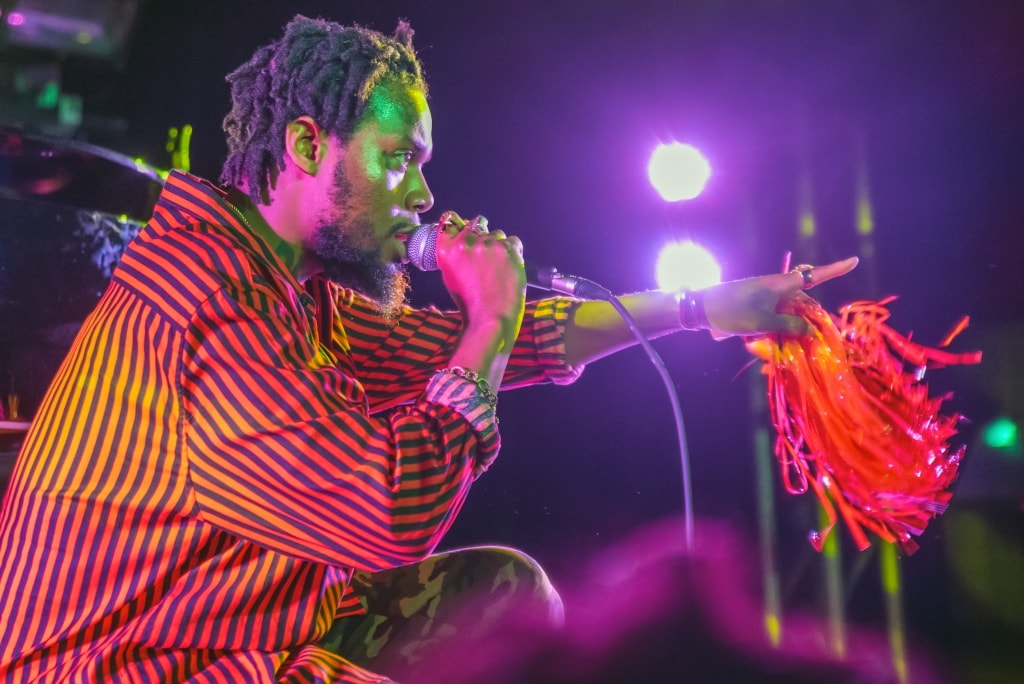
2019 hasn’t been a good year for R&B. Both Robert Kelly and Michael Jackson are in the middle of repugnant controversies (the latter posthumously), but after seeing serpentwithfeet, we now know there is hope within the genre. Baltimore-raised artist Josiah Wise can do anything vocally. His range knows no bounds, and his banter (which sometimes came in the middle of a song) is charmed to say the least. If you’re a fan of vocal range, give serpentwithfeet a listen knowing that it was without a doubt the smoothest show of the second day of the festival. – Rusty Odom
This Is Not This Heat

Beginning as spooky, creaky sounds, the kind which exist only in dark corners, the music created by the reunited lineup of the British experimental band eventually crept from the shadows and grabbed ahold of the sizable crowd at the Mill & Mine late in the afternoon on Saturday. Atonal vocal wails, reedy yet throaty, bellowed from an unknown source as enigmatic as the music itself. The set vacillated wildly, comprising everything from vaguely Middle-Eastern song structures that could be imagined sweeping across lonely desert vistas to Velvet Underground-style rhythmic drones propelled by tribal drumbeats.
As it progressed, the material grew more melodic – but not quieter. Bass tones rung out for unsettling, almost uncomfortably long periods of time, rattling the windows and doors of the former warehouse. Even the catwalk near the back of space could be heard vibrating. Blistering rock ‘n’ roll, dramatically different from what was on display at the start, closed the set in a powerful, forceful manner. – Matt Rankin
Nils Frahm
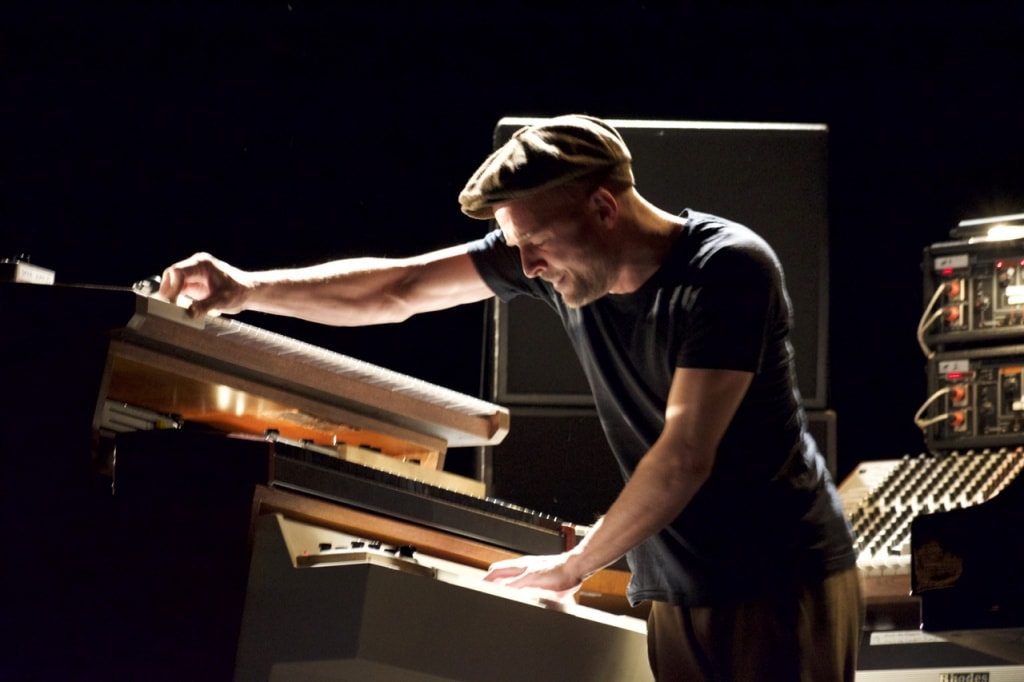
Sometimes even knowing all that a show will entail can’t prepare you for the experience of seeing it performed live. Such was the case with Nils Frahm on Saturday night. Despite having suffered earlier in the day from a bout of food poisoning (as the artist admitted in a humorous anecdote during the set’s one break for banter), the classically trained pianist and purveyor of highbrow electronica was in peak form throughout his hour-and-a-half primetime slot at the Tennessee Theatre.
Drawing mainly from last year’s “All Melody,” Frahm took the audience on a virtual tour of the cosmos, gradually building and looping tracks from scratch, adding layers upon layers of organic and electronic embellishments and manipulating all of it to glorious, dizzying effect – all while tirelessly bounding from one segment of the stage to another in order to play and record different instruments. Watching his mastery of the massive setup was the highlight of my weekend thus far; everything was so perfectly composed and expertly presented, but it all seemed so effortless.
A surprisingly dynamic light show enhanced what already was a grossly absorbing experience. I challenge anyone who claims to not like electronic music to watch Frahm creating his expansive art in real time. Aside from the delicious beats and instrumentation, the complexity and ambition on display are stunning and completely in line with what Big Ears is supposed to represent. – MR
Jerusalem in My Heart
Learning to appreciate experimental music can kind of be like getting in shape. At first, your muscles tire easily, you don’t have wide range of motion and you can’t lift very much weight. But as you exercise, you become stronger, you can stretch farther and you can lift more. That’s kind of like how it is with experimental music. I honestly would not have liked a second of this show six years ago. Over the years, though, I’ve stretched those muscles and have come to not only tolerate but enjoy the stuff that may be a bit out there.
Blending traditional Arabic vocals and strings with zippy synth, the humming drones and ocean sounds made by musician Radwan Ghazi were oddly melodic. It made me imagine a “Little Egypt” somewhere in Berlin, and that is pretty cool. Accompanying the sounds – and at times the star – was the projection of reel-to-reel film from the other part of this duo, filmmaker Charles-Andre Coderre, with the projectionist dancing between reels throughout the show. If this act floats through your town, I suggest giving it a chance. – JDR
“Coney Island” live soundtrack by Chris Eldridge; “The Films of Bill Morrison” live soundtrack by Bill Frisell, Tony Scherr and Kenny Wollesen
There was no chance that this event, featuring live musicians providing soundtracks to silent films, would not be special. Guitarist Bill Frisell is an old hand at this art, and having a short Fatty Arbuckle/Buster Keaton comedy with Punch Brothers member Chris Eldridge was icing on the cake. Eldridge, who played acoustic guitar, got the humor and, despite his virtuosity, never overdid it. It was just right for a likable comedy created more than a century ago.
The trio with Frisell, though, was amazing. Filmmaker Bill Morrison finds pieces of vintage industrial, educational and lost silent dramas and puts them together. He lets the flaws show. The most dramatic are the decaying films, with their images stretched, bubbled and blotted. Part of Saturday’s show featured a creepy section of a film starring Lionel Barrymore and Boris Karloff. The tinted film’s decayed state blended with the guitar, drum and bass-guitar magic that Frisell’s trio concocted into an almost psychedelic experience. It was a little like a 1960s light show, but with a story underneath.
Frisell is one of the world’s great improvisers and never ceases to create magic when he plays. Regular collaborators Scherr (bass) and Wollesen (drums) know how to create drama in music and Saturday’s show was terrific. – WB
Sons of Kemet

Saxophonist Shabaka Hutchings set a high bar with his first performance at Big Ears with The Comet is Coming, but somehow he surpassed it with his urgent, passionate and politically charged late-night show at the Mill & Mine with Sons of Kemet. With an unusual lineup of sax, tuba (Theon Cross made me reevaluate what a tuba is capable of) and two drummers, Sons of Kemet kept up a constant, pulsating, hip-hop/Caribbean beat, as Cross and Hutchings alternated between unison lines and extended solos. Hutchings’ impassioned speeches about Brexit and colonialism were welcome at a festival that has been noticeably free of politics, but nothing was going to detract from the relentless grooves that had everyone in the audience dancing from beginning to end. – BF
White Gregg
Local scene veterans Eric Lee, Maggie Brannon, Damion Huntoon, Tyler Mucklow and Pilot Light founder Jason Boardman are White Gregg. Brannon has an unusually arresting stage presence in that she hangs on the mic stand looking past the crowd from just over the edge of her glasses, exhibiting a stoic form of sleepy malaise as she talk-sings about distressing topics like “blood on the driveway … there was blood everywhere” while her bandmates churn out unsettling hardcore and post-punk all around her.
The rest of the group possesses a killer instrumental chemistry with one another, at once loose, frenetic and dynamic, hot, buzzy and dangerous-sounding. The large late-night crowd packed the small venue was getting a little sauced, talkative and disrespectful of the performance, but hey, just like a big-city punk show! – LB
12-Hour Drone
I was skeptical, hesitant and unsure, but sitting here in the center of this room, I am hooked, focused, uncomfortable, at ease, alert, relaxed, intrigued, curious, present and absolutely invincible. It’s like being in a bubble without having to be alone.
The music could be shifting towards a dark, uncomfortable place. Then, all of a sudden, the person laying fully at rest next to you starts lightly snoring and you’re brought back to a human space and feeling comforted. And then the music opens up, becomes whole and brighter, and you feel like you could hug everyone around you. – Mickey Ketron
Halfway home: A recap of the first two days of Big Ears 2019



